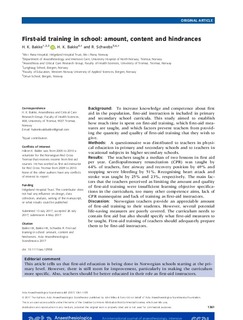| dc.contributor.author | Bakke, Håkon Kvåle | |
| dc.contributor.author | Bakke, Harald Kvåle | |
| dc.contributor.author | Bjørlo Schwebs, Runa | |
| dc.coverage.spatial | Norway | nb_NO |
| dc.date.accessioned | 2019-03-14T09:08:17Z | |
| dc.date.available | 2019-03-14T09:08:17Z | |
| dc.date.created | 2017-08-18T10:56:59Z | |
| dc.date.issued | 2017 | |
| dc.identifier.citation | Bakke, H. K., Bakke, H. K., & Schwebs, R. (2017). First-aid training in school: amount, content and hindrances. Acta Anaesthesiologica Scandinavica, 61(10), 1361-1370 | nb_NO |
| dc.identifier.issn | 0001-5172 | |
| dc.identifier.uri | http://hdl.handle.net/11250/2589950 | |
| dc.description.abstract | Background:
To increase knowledge and competence about first aid in the population, first‐aid instruction is included in primary and secondary school curricula. This study aimed to establish how much time is spent on first‐aid training, which first‐aid measures are taught, and which factors prevent teachers from providing the quantity and quality of first‐aid training that they wish to give.
Methods:
A questionnaire was distributed to teachers in physical education in primary and secondary schools and to teachers in vocational subjects in higher secondary schools.
Results:
The teachers taught a median of two lessons in first aid per year. Cardiopulmonary resuscitation (CPR) was taught by 64% of teachers, free airway and recovery position by 69% and stopping severe bleeding by 51%. Recognising heart attack and stroke was taught by 25% and 23%, respectively. The main factors that the teachers perceived as limiting the amount and quality of first‐aid training were insufficient learning objective specifications in the curriculum, too many other competence aims, lack of CPR mannequins and lack of training as first‐aid instructors.
Discussion:
Norwegian teachers provide an appreciable amount of first‐aid training to their students. However, several potential life‐saving measures are poorly covered. The curriculum needs to contain first aid but also should specify what first‐aid measures to be taught. First‐aid training of teachers should adequately prepare them to be first‐aid instructors. | nb_NO |
| dc.language.iso | eng | nb_NO |
| dc.publisher | Wiley-Blackwell Publishing Inc. | nb_NO |
| dc.rights | Navngivelse 4.0 Internasjonal | * |
| dc.rights | Navngivelse-Ikkekommersiell 4.0 Internasjonal | * |
| dc.rights.uri | http://creativecommons.org/licenses/by-nc/4.0/deed.no | * |
| dc.title | First-aid training in school: amount, content and hindrances | nb_NO |
| dc.type | Journal article | nb_NO |
| dc.type | Peer reviewed | nb_NO |
| dc.description.version | publishedVersion | nb_NO |
| dc.rights.holder | © 2017 The Authors | nb_NO |
| dc.subject.nsi | VDP::Samfunnsvitenskap: 200::Pedagogiske fag: 280::Fagdidaktikk: 283 | nb_NO |
| dc.subject.nsi | VDP::Medisinske Fag: 700::Helsefag: 800 | nb_NO |
| dc.source.pagenumber | 1361-1370 | nb_NO |
| dc.source.volume | 61 | nb_NO |
| dc.source.journal | Acta Anaesthesiologica Scandinavica | nb_NO |
| dc.source.issue | 10 | nb_NO |
| dc.identifier.doi | 10.1111/aas.12958 | |
| dc.identifier.cristin | 1487159 | |
| cristin.unitcode | 203,1,0,0 | |
| cristin.unitname | Avdeling for lærerutdanning - Bergen - Bergen | |
| cristin.ispublished | true | |
| cristin.fulltext | original | |
| cristin.qualitycode | 1 | |

